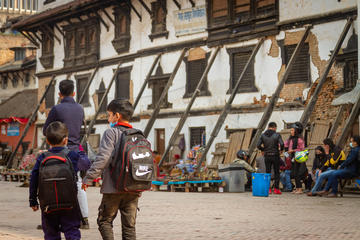Re-thinking education in South Asia
Understanding the many ways in which education intersects with social and political ideas and identities is a topic that fascinates Dr Uma Pradhan. Uma was first a Leverhulme Career Development Fellow and then a Departmental Lecturer in South Asian Studies in OSGA, and she continues to contribute to OSGA teaching and activities as a research associate. During her years at OSGA she was engaged in a study of the Nepalese government’s involvement in school and education reconstruction following the 2015 earthquake when an even larger crisis – the covid-19 pandemic – erupted, radically overturning the way education is delivered and opening up new vistas for research and collaboration.

Students with masks arrive at their earthquake-affected school as Nepal's education system faces the covid crisis while still recovering from the 2015 earthquake (photo: Uddhav Pradhan)
‘I was looking at how the state of Nepal was trying to restore its education system while at the same time rebuilding itself;’ says Uma. ‘As a way of investigating the social and political dimensions of education, together with research students I set up a website to host an initiative which we called “Education.SouthAsia”. The aim was to facilitate our public engagement activities and look at how people actually experience education.’
‘The pandemic put an abrupt stop to our fieldwork so, with funding from the University of Oxford’s “Public Engagement with Research” Seed Fund, I commissioned a local cameraman to work with us to make Lockdown Diaries, a short documentary that captures what going to a government school means for students in Nepal amidst the uncertainties created by both the 2015 earthquake and the pandemic.’
The site also began to publish ‘think pieces’ – original and analytic short research articles that made interdisciplinary contributions to understanding the issue of education in South Asia. ‘Submissions starting coming in from all over the world and it became apparent that we had the makings of a lively research hub on our hands,’ says Uma.
Most education systems in South Asian countries are broadly British-style, with classroom teaching and national examinations. There are both public (state) and private schools and sometimes also religious or other schools, though governments generally are trying to bring systems together so that all children get a similar style of education. But of course huge variations in national economic and social conditions mean that the pandemic has exacerbated inequalities such as ease of internet access to online teaching as well as highlighting new opportunities for education.
To examine how education practitioners, policymakers and academics responded to the crisis and identify the recovery and rebuilding needed to move forward, Uma and her colleagues announced on Facebook a two-day online conference. ‘The response was overwhelming,’ says Uma. ‘Over 500 abstracts were submitted and it was clear that people very much wanted to talk about how the pandemic was forcing us to rethink our approach to education.’
In July 2021, Education in Crisis: re-thinking education in post-pandemic South Asia presented a programme featuring more than 100 speakers, with research presentations and round table discussions plus poster submissions. More than 800 participants from around the world registered for the conference, with at least 300 attending live via Zoom and many more using the 'Education.SouthAsia' YouTube channel. Participants included very senior school and university educationalists and government representatives, such as Sri Lanka’s Director of Education and attendees from India’s National Institute of Educational Planning and Administration, the Association of Indian Universities, Afghanistan’s School of Leadership, and Nepal’s National Planning Commission. Very positive feedback shows that the meeting has generated many new international research collaborations.
‘We were able to share many aspects of the difficulties in education caused by covid,’ says Uma. ‘We looked at the different online platforms being used and which ones schools and students thought best. We learned that many students were highly motived and enjoyed self-study but had very real and distressing difficulties when internet and radio signals were patchy or non-existent. For some students, especially if they usually had to walk many miles to school, online learning was a real benefit, though, for others, trying to study in a noisy home environment was a problem. Importantly, we learned that digital education is not the only alternative to learning. While some teachers took the classroom outdoors, for many students the different activities they undertook at home – developing farming or domestic skills, trying to make or repair a wireless or maybe starting to do programming, for example, – are all valuable forms of learning that we do not formally assess. This is expanding the way we understand education.’

Students with masks and social distancing as education institutions follow covid precautions. Studies suggest that 20 million girls in developing countries may never return to the classroom after the pandemic.
She adds: ‘The pandemic has provided a lens for us to focus on the challenges and inequalities we see in education in South Asia, whether they be technological disparities or social expectations that, for example, girls perform household chores. The alliance of like-minded professionals we are now building through OSGA’s 'Education.SouthAsia' network will allow us to explore how education is delivered across the region and influence policymakers.’
Read more about Uma’s work here.
Links to the conference proceedings are here.
Conference presentations on YouTube are here.
Read other Impact Spotlights here.
Picture on OSGA Spotlights home page: Online home class learning during the coronavirus pandemic May 2020 regional lockdown in Kathmandu, Nepal (photo: gorkhe1980)





